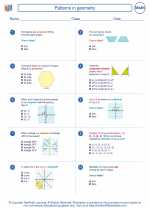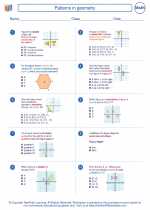Sequences
A sequence is a list of numbers in a specific order. The numbers in a sequence are called terms. Each term in a sequence is identified by its position, or index, in the sequence. Sequences can be finite (having a limited number of terms) or infinite (continuing indefinitely).
Types of Sequences
Sequences can be classified into different types based on the pattern of their terms. Some common types of sequences include:
- Arithmetic Sequences: In an arithmetic sequence, each term is obtained by adding a constant value to the previous term. The constant value added is called the common difference. The general form of an arithmetic sequence is: an = a1 + (n - 1)d, where an is the nth term, a1 is the first term, n is the position of the term, and d is the common difference.
- Geometric Sequences: In a geometric sequence, each term is obtained by multiplying the previous term by a constant value. The constant value used for multiplying is called the common ratio. The general form of a geometric sequence is: an = a1 * r(n-1), where an is the nth term, a1 is the first term, r is the common ratio, and n is the position of the term.
- Fibonacci Sequence: The Fibonacci sequence is a special sequence where each term is the sum of the two preceding terms. The sequence starts with 0 and 1, and then each subsequent term is the sum of the previous two terms (e.g., 0, 1, 1, 2, 3, 5, 8, 13, ...).
Sum of a Sequence
The sum of the terms in a sequence can be calculated using the concept of series. A series is the sum of the terms in a sequence. For example, the sum of the first n terms of an arithmetic sequence is given by the formula: Sn = (n/2)(a1 + an), where Sn is the sum of the first n terms, a1 is the first term, and an is the nth term.
Understanding sequences is important in mathematics, as they are used in various areas such as number patterns, mathematical induction, and even in real-world applications like finance and computer science.
Hopefully, this explanation helps you understand the concept of sequences better!
[Sequences] Related Worksheets and Study Guides:
.◂Math Worksheets and Study Guides Eighth Grade. Patterns in geometry

 Worksheet/Answer key
Worksheet/Answer key
 Worksheet/Answer key
Worksheet/Answer key
 Worksheet/Answer key
Worksheet/Answer key
